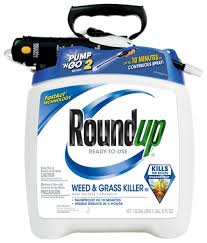 Monsanto is trying to dismiss more than 250 Roundup lawsuits in U.S. District Court in San Francisco. The suits were filed by people who allege exposure to Roundup herbicide caused them or their loved ones to develop non-Hodgkin lymphoma. The suits all charge that Monsanto covered up Roundup risks. The cases have been combined in a multi-district litigation action under Judge Vince Chhabria. The lead case is 3:16-md-02741-VC.
Monsanto is trying to dismiss more than 250 Roundup lawsuits in U.S. District Court in San Francisco. The suits were filed by people who allege exposure to Roundup herbicide caused them or their loved ones to develop non-Hodgkin lymphoma. The suits all charge that Monsanto covered up Roundup risks. The cases have been combined in a multi-district litigation action under Judge Vince Chhabria. The lead case is 3:16-md-02741-VC.In addition, at least 1,100 plaintiffs have made similar claims against Monsanto in state courts across the country. The first trial in the Roundup litigation is scheduled for June 18, 2018 in the Superior Court for the County of San Francisco.
On March 13, 2017, U.S. District Judge Vince Chhabria ruled that certain documents obtained by plaintiffs through discovery could be unsealed, over Monsanto’s attorneys’ objections.
U.S. Right to Know has reported the documents listed below will include discovery materials, transcripts of court proceedings, depositions and other case-related items.
The schedule for adjudication of the MDL litigation as of July 2017:
• Close of Expert Discovery due by 9/22/2017.
• Defendant’s Summary Judgment and Daubert Motions due by 10/6/2017.
• Plaintiffs’ Cross Motions and opposition due by 10/27/2017.
• Live testimony from witnesses set for 12/11/2017 through 12/14/2017 09:00 AM.
• Summary Judgment and Daubert Hearing set for 12/15/2017 09:00 AM.
Meanwhile, a joint committee of the European Parliament is holding a hearing into the revelations contained in the discovery documents obtained through the MDL litigation on Oct. 11, 2017.
Discovery Documents show Monsanto EPA Collusion
Discovery documents in the litigation have revealed how EPA officials working secretly with Monsanto helped the company portray Roundup as safe. They also reveal Monsanto executives discussing the ghostwriting of research literature in the name of academics like Stanford’s Henry Miller.
Monsanto manufactured Outrage at IARC
When the International Agency on Cancer Research declared in 2015 that glyphosate – in Roundup and other Monsanto pesticides – is a probable carcinogen, Monsanto went to work behind the scenes to manufacture outrage with astroturf organizations that it controlled. Documents released in the litigation show just how Monsanto called in scientists to protect its flagship product after it had been shown in dozens of studies to be a probable carcinogen. The scientists presented themselves as “independent,” while paper and email trails now show that nothing could be further from the truth. Most were former Monsanto employees, or had other financial ties or mutual interests with Monsanto.
Monsanto was terrified at the IARC’s review of glyphosate. Internal Monsanto emails included: “It is possible that IARC’s decision will impact future regulatory decision making.”
Monsanto knew the timing was vital. In 2015, both the U.S. EPA and the European Commission were evaluating re-authorizations of Monsanto’s Roundup. Following the IARC’s classification, both the EU and the EPA delayed final decisions on glyphosate.
Whitewash
Carey Gillam just-released an eye-opening book called Whitewash (2017), which details Monsanto’s corruption of, and collusion with, government regulators. Ms. Gillam notes just how important Monsanto knew it was to discredit the IARC. She quotes Peter Infante, an epidemiologist who worked for more than 24 years for the U.S. government studying cancer risks from toxic exposures.
Mr. Infante spoke of Monsanto’s falsely manufacturing outrage at the IARC: “What this indicates to me is that it was obvious to Monsanto that there was evidence of carcinogenicity. It would seem to me that Monsanto does not like the public to be informed of the cancer hazard.”
After the IARC ruled glyphosate a probable carcinogen, some Monsanto-connected scientists questioned the wisdom of U.S. funding for IARC. Monsanto has since perpetuated a false story that the chairman of the IARC working group withheld critical information from the team.
Monsanto’s Manufactured Dissent
Monsanto’s telling document trail includes internal emails, memos and other communications obtained by plaintiffs’ attorneys suing Monsanto in the U.S.. That trail makes clear that the challenge to IARC’s classification did not come organically from a variety of voices. The “outrage” was manufactured by Monsanto prior to IARC’s decision, and it continued afterward. The goal was, and is, to bully regulators into discounting the findings of the team of independent scientific experts who made up the IARC team that reviewed glyphosate.
Monsanto’s Decades-Long Subterfuge
The internal records obtained through Roundup cancer lawsuits, combined with documents obtained through Freedom of Information Act (FOIA) and state records requests, also show that the actions employed to discredit IARC were part of a decades-long pattern of deceptive tactics by Monsanto. The company has spent millions in working behind the scenes to manipulate regulators, lawmakers, and members of the press and public into believing glyphosate and Roundup are safe. Monsanto has used these tactics over the years to attack and discredit several scientists whose research has found glyphosate and Roundup harmful.
Monsanto: “Orchestrate Outcry”
Monsanto’s IARC attack plan was laid out in an internal February 2015 memo. It involved not only Monsanto’s internal PR people, scientists and marketing experts, but many outside industry players. Various individuals were assigned tasks. The “strategies and tactics” evidenced from Monsanto’s own files included:
“Orchestrate Outcry” with IARC Decision – Industry conducts robust media/social media outreach on process and outcome.
“Identify/request third-party experts to blog, op/ed, tweet and/or link, repost, retweet, etc.” The documents reveal one such paid shill, so-called “expert,” academic Henry Miller. He was provided a draft article to submit to Forbes for publication under his name, without mentioning his financial ties to the company. Forbes learned of the deceit in October 2017, and said it severed ties with Mr. Miller.
“Inform/Inoculate/Engage Industry Partners” – Notably the industry partners listed included three organizations that purport to be independent of Monsanto, but have long been seen by critics as front groups for the company – Monsanto named ‘Academics Review’ and the ‘Genetic Literacy Project.’ Both are Monsanto PR companies based in the U.S.. Monsanto also named ‘Sense About Science,’ which has run operations for Monsanto in the United Kingdom and the U.S. ‘Sense About Science’ was the astroturf group named by Monsanto to lead the industry response and “provide a platform for IARC observers.” The groups did as Monsanto planned, posting scathing attacks on IARC on their websites.
Engagement with Regulatory Agencies
Monsanto planned for grower associations / growers to “write regulators with an appeal that they remain focused on the science, not the politically charged decision by IARC.”
“Push opinion leader letter to key daily newspaper on day of IARC ruling” with assistance of the Potomac Group marketing firm.
Monsanto’s “preparedness plan” against the IARC also called for supporting “the development of three new papers on glyphosate focused on epidemiology and toxicology.” As planned, shortly after the IARC decision hit the news, Monsanto arranged for several scientists – many of them former employees or paid consultants – to author and publish research papers supporting glyphosate safety.
Monsanto tries to Dismiss Roundup Lawsuits
There is little Monsanto won’t do to protect its flagship chemical, glyphosate, which stands as the cornerstone of its poison products’ business model. Meanwhile the much greater danger is Roundup, of which glyphosate is only the main active ingredient. Roundup is many times more dangerous than glyphosate. In keeping the argument narrowed to glyphosate, Monsanto is keeping regulators farther away from the much larger problem of Roundup. We will hope that Judge Vince Chhabria sees through the subterfuge and allows Monsanto to stand trial.
Related
- How Monsanto Manufactured Outrage over IARC
- Monsanto Lawsuit
- Roundup Non-Hodgkin’s Lymphoma Lawsuit
- Stanford Academic Monsanto Shill
- Editor on Monsanto’s Payroll retracted Roundup Cancer Study

by Matthews & Associates




